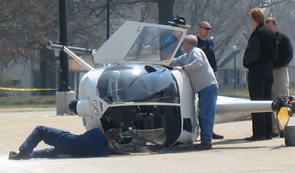WUPD test emergency training
April 13, 2008
Washburn University Police Department Sergeant Chris Enos was in Carnegie Hall when he heard the call come in that a helicopter had crashed in the parking lot north of Stoffer Science Hall.
While Enos was not the first officer on the scene, he and three other WUPD officers were called in to serve as support while the Topeka Police Department and Kansas State Highway Patrol surveyed and investigated the crash.
Dean Forster, Washburn University chief of police, said it’s difficult to prepare for something as unexpected as a helicopter crash. However, WUPD officers called to the scene worked with other law enforcement officers to handle the emergency situation in a cool and collected manner.
“This particular situation, on the part of the Topeka Police Department and the Washburn Police Department, was exceptionally well-handled,” said Forster, who has served in law enforcement for 38 years.
Forster added one reason the situation was handled well was because of the training that police officers nationwide have received in emergency management. Incident Command System and National Incident Management System training techniques have been in existence for several years prior to Sept. 11, 2001, but it was not until after the attack on the World Trade Center that the training was kicked into high gear. Forster noted that this training allows officers from multiple police forces to band together to handle an emergency situation without working out which methods or jargon that would be used. In an effort to continue emergency training, WUPD will work in conjunction with volunteers on campus to make Washburn University a central hub for emergency medicine distribution in the event of something such as a pandemic.
Darrell Dibbern, director of risk management and campus safety, said that on May 22 Washburn will conduct a drill to test the readiness of the program that will be implemented. Designed to make the university a central dispersion point in a situation where large portions of the population need to be inoculated, Lee Arena will serve as home base for the operation. WUPD would act as crowd control within Petro Allied Health Center if such an event occurred, with other law enforcement agencies positioned outside the building.
Another program Dibbern said the university was working to implement was an emergency notification system.
“A lot of universities across the country have looked at notification systems for students, staff and faculty,” said Dibbern.
The $16,000 emergency notification system would be used for alerts ranging anywhere from severe weather to a shooter on campus. While a form of notification is already being utilized by WUPD in the form of e-mails, the system would expand far beyond that toward automated phone calls and even text messages sent straight to the cell phones of Washburn students, faculty and staff. Notifications in the form of either phone calls or text messages will be on a strictly volunteer basis, as phone numbers will not be automatically put into the system database.
The emergency notification system is set to kick off this August.



